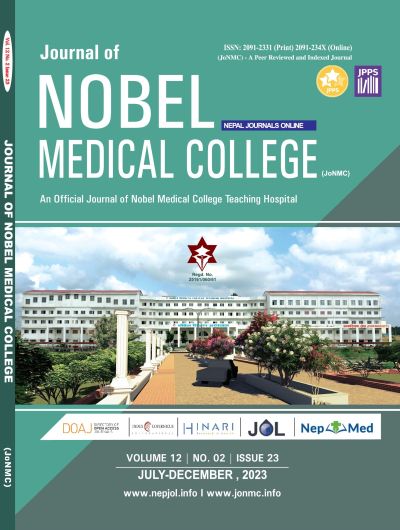Transabdominal Pre-Peritoneal Versus Totally Extraperitoneal Laparoscopic Techniques for Inguinal Hernia Repair in Eastern Nepal
DOI:
https://doi.org/10.3126/jonmc.v12i2.61346Keywords:
Inguinal hernia, Laparoscopic Surgery, FixationAbstract
Background: Inguinal hernia is one of the most common surgical problems in the world, with a high risk in men. The treatment modalities have evolved from open to laparoscopic procedures. Laparoscopic procedures are getting attention and widespread utilization among surgeons. The choice between the two procedures is still a debate between the surgeons. This study aims to compare the transabdominal pre-peritoneal approach to the totally extraperitoneal approach in its perioperative outcomes.
Materials and Methods: A prospective analytical study was conducted on 86 adult patients, who underwent laparoscopic inguinal hernia reduction between June 2022 to June 2023 at Nobel Medical College Teaching Hospital in Biratnagar, Nepal. The patients were randomized into two groups of 43 participants each and were analyzed on different variables.
Results: All of the 86 patients included in the study were male. Among them, 30.23% of patients had direct inguinal hernia. There were 12.79% of patients with bilateral hernias. There was a statistically significant difference in the duration of operation among the patients undergoing totally extraperitoneal and transabdominal preperitoneal hernia repair. Total duration of hospital stay was shorter in totally extraperitonealand postoperative pain was slightly lesser in totally extraperitoneal procedure. The intraoperative and postoperative complications among totally extraperitoneal and transabdominal preperitoneal hernia repair were comparable. There was no conversion to open procedure or recurrence of hernia during the study period. The return to daily life took longer in the transabdominal preperitoneal procedure than in the totally extraperitoneal hernia repair.
Conclusion: Totally extraperitoneal hernia repairhas an advantage over transabdominal preperitoneal hernia repairin terms of shorter operative time, postoperative pain, duration of hospital stays, and return to daily life.
Downloads
Downloads
Published
How to Cite
Issue
Section
License
Copyright (c) 2023 Dinesh Adhikari, Amit Bhattarai, Bivusha Parajuli, Anil Kumar Mehta, Dipak Kumar Yadav, Saurav Poudel

This work is licensed under a Creative Commons Attribution 4.0 International License.
JoNMC applies the Creative Commons Attribution (CC BY) license to works we publish. Under this license, authors retain ownership of the copyright for their content, but they allow anyone to download, reuse, reprint, modify, distribute and/or copy the content as long as the original authors and source are cited.




